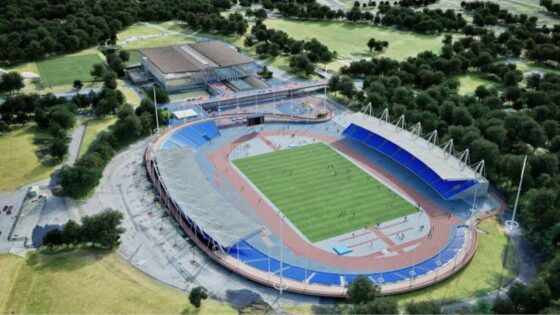For years, it sat quietly, tired, forgotten, and slowly crumbling behind its historic facade. The Crystal Palace National Sports Centre, once buzzing with world-class track and field athletes and roaring crowds, had become something closer to a relic. Locals walked by with memories; others didn’t even know what used to be. But what if we told you that behind the scenes, something huge is in motion? Something that could flip the switch on London’s entire sporting future?
Let’s rewind for a second. Built in 1964, this site isn’t just any sports centre, it’s sacred ground. The FA Cup finals were once played here. From the 1950s through 2012, it hosted the biggest international athletics meets, including nights when names like Usain Bolt and Mo Farah lit up the track. But since then, it’s been in a steady decline. Pools shut down. The tracks cracked. Even the stadium felt abandoned. In 2023, The Times called it out: it was time to stop pretending it could survive without real change. But…
Sadiq Khan with a $174 million answer. The Mayor of London has launched a full-scale, once-in-a-generation redevelopment plan aimed at not just fixing, but transforming the Crystal Palace site. Leading the charge is Ben Woods, the same architect who helped shape the 2022 Commonwealth Games in Birmingham. And just recently, Morgan Sindall Construction was appointed to bring it all to life. Expect a new 200m outdoor track and field, a modern 100m indoor sprinting facility, a rebuilt swimming complex, and a full revamp of the Grade II-listed main building. “It’s great for the project that the planning application we submit later this year will be for the whole centre,” Woods said. But that’s not the whole story.
This isn’t just about aesthetics or even athletic performance. It’s about community, sustainability, and London’s long game. The centre has already received $30.88 million from Khan’s Green Finance Fund to transition to an all-electric system and slash carbon emissions. Short-term fixes like temporary floodlights and track repairs have already begun. And yes, Khan wants to see Diamond League events return to Crystal Palace by 2028.
“I want to see Diamond League events at Crystal Palace,” Khan said. “That would be great. I grew up watching Seb Coe, Steve Ovett, Steve Cram, and Daley Thompson competing at Crystal Palace. They were magical nights, with people also watching on terrestrial TV. Let’s be frank. It’s been neglected, but I want Crystal Palace to be rolestored to its former glory.” He’s even hinted that this site could play a part in a future bid for the 2040 Olympic Games.
“We can still have Diamond League athletics at the London Stadium, but we can have Crystal Palace too,” Khan said. It’s an ambitious vision, but with planning applications going in later this year and major construction set to start by late 2026, this quiet corner of southeast London could soon be roaring again. Not just with cheers, but with new energy, new purpose, and a new generation of track and field athletes, ready to run. Can this redevelopment truly succeed and restore Crystal Palace to its former glory? History shows it’s possible, just like other venues that faced decline but rose again to greatness. And it feels like Sadiq Khan has a plan.
“We’re working with experts. Ben Woods was part of the team behind the Commonwealth Games in Birmingham, and we’re bringing in the right people. There’s no downside to redeveloping Crystal Palace. The community will benefit, the restaurants will benefit, the public transport will benefit, and the parks will benefit,” He said. And that’s a story for the history books to tell in the future. The restoration at Birmingham was also a tale of grit leading to glory.
Birmingham’s track and field landmark restored to inspire
Alexander Stadium in Birmingham was long considered the heart of British athletics. Since its opening in 1976, it has hosted iconic national track and field championships and international events, including the AAA Championships and the British Grand Prix. Legendary athletes such as Linford Christie, Sally Gunnell, and Jonathan Edwards competed here, setting records and thrilling crowds. For decades, it was the go-to venue for elite track and field in the UK. But as years passed, the stadium’s facilities became outdated, seating was limited, the infrastructure aged, and it lacked the modern amenities needed to host world-class competitions. By the 2010s, Alexander Stadium was struggling to maintain its status amid growing competition from newer venues.
That all changed when Birmingham won the bid to host the 2022 Commonwealth Games. The city invested $96.60 million in a major redevelopment project that transformed the stadium into a state-of-the-art athletics venue. The new West Stand boosted capacity to 18,000 seats, expandable to 30,000 for major events, while new training facilities and community spaces were added.
The stadium proudly hosted the opening and closing ceremonies of the Games and key track and field competitions. Today, Alexander Stadium serves not only as a premier sports venue but also as a community hub, hosting local athletics clubs, training sessions, and national competitions. Its successful rebirth shows how historic venues can be revitalized to inspire future generations while honoring their rich sporting legacy.
The post Massive $175 Million Investment Set to Transform Iconic Track and Field Stadium as Mayor Drops Strong Statement appeared first on EssentiallySports.



